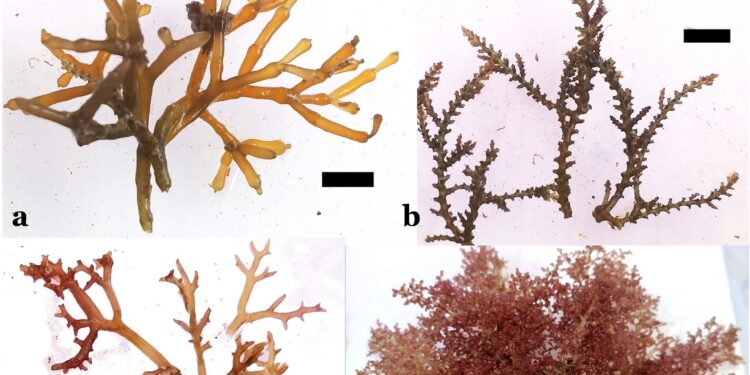Plant material for each species studied. Credit: Scientific reports (2024). DOI: 10.1038/s41598-024-74555-6
If you pass through certain shorelines in Hawaii (especially the south and east shores of O’ahu, parts of Maui and Hilo) and notice algae in the water, there’s a good chance it’s invasive and non-native species. And it could have a detrimental effect on the seafood we eat and the health of coral reefs.
Botanists at the University of Hawaii at Mānoa have discovered key survival strategies used by invasive algae species in coastal ecosystems, potentially explaining their dominance over native Hawaiian limu in certain habitats. Coastal ecosystems extend up to 300 feet offshore, encompassing shallow coastal waters where land and ocean environments interact and where many marine species live and feed.
An October 2024 study published in Scientific reports discovered that invasive species such as “gorilla ogo” and “spiky algae” thrive in areas of underwater groundwater discharges, where daily tidal cycles create extreme fluctuations in salinity (salt level) .
“Understanding how invasive algae outcompete native limus is crucial to expanding our knowledge of reef and ocean environments,” said Veronica Gibson, a postdoctoral researcher in the UH Mānoa Hawai‘i Institute of Marine Biology, at the He’eia National Estuarine Research Reserve and the UH Mānoa School of Life. Doctorate in Science graduated.
“These spring-fed coastal areas are unique ecosystems that directly connect our land use practices to ocean health, and what happens to limu, which forms the basis of our marine food web, affects everything from fish we catch to the overall health of our coral reefs.
Study site and areas. Random points were generated for sample collection in each predetermined area. Credit: Scientific reports (2024). DOI: 10.1038/s41598-024-74555-6
Advanced techniques
The research team used advanced plant biology techniques to study how different species of algae cope with these harsh conditions. Their key method was to measure how algae cells adjust their internal chemistry when exposed to changing salt levels in the water.
Just as a dried grape swells in water, algae cells respond to changes in their environment. Scientists have discovered that successful species can quickly change the concentration of dissolved substances inside their cells to adapt to external changes. This ability to regulate internal water pressure is crucial for survival. Algae species that cannot adapt quickly enough suffer serious damage: their cells burst from absorbing too much water or shrivel from too much water loss.
Invasive species have demonstrated remarkable adaptability and have evolved other survival tactics. Both types had thinner cell walls in areas affected by springs, while the ogo gorilla showed a peak in photosynthesis near freshwater springs and developed smaller cells to better handle stress.
Native species, including Limu maneʻoneʻo, were notably absent from spring-influenced areas, although they exhibit cellular characteristics similar to those of invasive species from offshore environments.
These findings come as human activity continues to impact watershed systems and underwater groundwater discharges. Submarine groundwater flow occurs when fresh water from underground aquifers infiltrates or flows directly into the ocean through the seafloor, creating areas where fresh water and salt water mix near the shore.
Researchers emphasize the importance of understanding how native species survive in these conditions, as changes in water quality and quantity affect coastal ecosystems, potentially influencing food webs and coral cover. Further research will focus on the tolerance of native limus and link the findings to watershed management strategies, particularly in areas affected by nutrient pollution from groundwater sources.
Other authors of the paper are Angelene Dedloff, who received her bachelor’s degree from the UH Mānoa School of Life Sciences; Lisa Miller, assistant professor at Kapi’olani Community College; and Celia Smith, professor in the UH Mānoa School of Life Sciences.
More information:
Veronica L. Gibson et al, Integrated physiological response of four species of Rhodophyta to submarine groundwater discharges reveals complex patterns among closely related species, Scientific reports (2024). DOI: 10.1038/s41598-024-74555-6
Provided by University of Hawaii at Manoa
Quote: Invasive algae could adapt to changes better than native species in Hawaii waters (October 14, 2024) retrieved October 14, 2024 from
This document is subject to copyright. Except for fair use for private study or research purposes, no part may be reproduced without written permission. The content is provided for informational purposes only.



